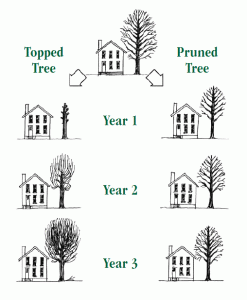Crown Reduction Vs Topping

What Are Topping and Crown Reduction Pruning?
Topping is used only when removing an unwanted tree. It should never be used as a primary pruning practice for reducing the height or spread of a tree. “Heading” is the method used to reduce the trunk or branches of a tree to stubs, or for the removal of smaller lateral branches which cannot assume the terminal role of the branch being cut. Even though topping can provide short-term control of tree size, topping causes serious future problems. When a tree or shrub is topped, several things happen:
1. The branch at the point of the heading cut produces a flush of new growth, usually numerous, vigorous and disorganized sprouts. This “witch’s broom” of new growth destroys the tree’s natural growth. Sprouts are often long and upright with little variation in shape and structure.
2. In producing such profuse growth to replace the lost foliage, the plant is soon as tall as it was before topping. But now the crown is denser, requiring extra time and effort to prune.
3. The sprouts also create a foliage shell, shading the plant’s interior, often causing inside branches to die.
4. Finally, the new sprouts are weakly attached, crowded and prone to breakage. Although topping is sometimes done to make trees safer, trees can become more hazardous after topping.
Never plant medium or large trees near or under utility lines, awnings, or anywhere else that will require extensive pruning to keep them from damaging property. Pick the right tree for the right site and you will not have extensive pruning damage or topping problems. Conifers should never be topped.
The better alternative is Crown Reduction pruning.
Crown reduction pruning, sometimes called drop-crotch pruning, is most often used when a tree has grown too large for its permitted space. This method is preferred to topping because it results in a more natural appearance, increases the time before pruning is needed again, and minimizes stress. This special procedure removes the end of a branch by cutting back to a “crotch” created by a lateral branch. The side branch needs to be at least 1/3 the diameter of the branch being cut so that water and nutrients will be redirected into the lateral branch and it can then assume the primary growth responsibility of the removed branch. Employing this method insures the tree will produce fewer sprouts at the point of the cut and the tree’s natural growth will be preserved.

Pruning Season
In the real world, the time of year to prune is when the saw is sharp and you are
thinking about it. Trees are resilient to abuse and damage even if you prune in the wrong season. Late dormant-season pruning is usually recommended, although some trees will ooze liquid if cut too close to the time of spring growth.
One period to avoid is when buds are expanding in the spring. Do not prune once
buds first start to expand until after the leaves are at their mature size. Pruning during this period can disrupt tree growth and stress trees badly.
Pines should not be pruned during the warm months. Dormant-season pruning during
cold periods is best to prevent pruning-associated insect problems.
Wound Paints
Do not use wound paints. Wound paints are primarily cosmetic and many disturb and disrupt the ability of the tree to seal off wound sites. Wound paints do not prevent decay.
If unavoidable, use a commercial tree wound paint to color the wound area. Do not
use black tar-like paints, since these can inhibit wound closure and kill surrounding tissue. Do not use latex or oil house paints because the paint carriers disrupt wound closure.
You should not scribe, cut or try to shape or sterilize pruning wounds. This damages
the branch collar at the base of the pruned branch and can lead to many bad structural and biological problems.
Minimize any mechanical damage to the trunk of a tree and you will have a healthy,
long-lived tree.
Contact Green Leaves Tree Service today at 219-877-8263

